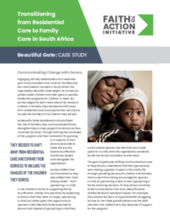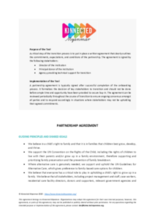Achieving full and final buy-in
The aim of this stage is to secure full buy-in from all key decision makers for the strategic plan and organization’s approach to transition. This helps to keep a complex process with many moving parts on track and ensures actions are prioritised and undertaken in the right order. A strategic plan also gives visibility to everyone involved as to what will happen and when, which reduces the likelihood of misunderstanding and tension arising along the way.
Agreement on the strategic plan will minimize the risk of the transition being derailed during the implementation phase, which can happen due to serious misunderstandings, stakeholder sabotage (particularly when risks aren’t identified or managed) or due to the premature exit from the process of a key stakeholder (director, donor, technical partner).
This stage is concerned with consensus building and securing buy-in for the transition plan.
Key actions outworked during this stage may include:
- Identifying and addressing remaining barriers to stakeholder buy-in. This could be amongst:
- Senior leaders/staff
- Board members
- Principal donors
- Government authorities (can be relevant where an agreement to cease referrals/new admissions is required in order to proceed with transition)
- Governing body or advisory board trainings
- Facilitating discussions to help the organisation agree to very clear end goals and key principles that will keep the transition on track.
- Signing all parties into a partnership agreement that has clear goals and states the commitments each party is making to and throughout the transition (director, principal donor/s, technical support partners, board).
The key milestones associated with this stage are, the organization’s key decision makers have:
- Made a final decision as to whether the organisation is pursuing full transition, safe closure or divestment (for a funding entity)
- A clear agreement signed by all key decision makers to proceed with the Transition.
- A clear articulation of the high-level commitments and obligations of the key decision makers in progressing the transition (director, donor, founder, government, technical partners)
Resources
Displaying 1 - 2 of 2
Engaging with key stakeholders is an essential part of any transition and must be handled with tact and wisdom. Located in South Africa, the organization Beautiful Gate began its ministry to protect street children and later grew to provide residential programs for children in need. Yet, as they began to learn more about the needs of children in families, they decided to shift away from residential care and expand their services to include the families of the children they served. This case study summary explains how Beautiful Gate communicated these changes with donors.
A critical step of the transition process is to put in place a written agreement that clearly outlines the commitments, expectations, and conditions of the partnership. A partnership agreement is typically signed after successful completion of the onboarding process. It formalizes the decision of key stakeholders to transition and should not be done before ample time and opportunity have been provided to secure buy-in.


